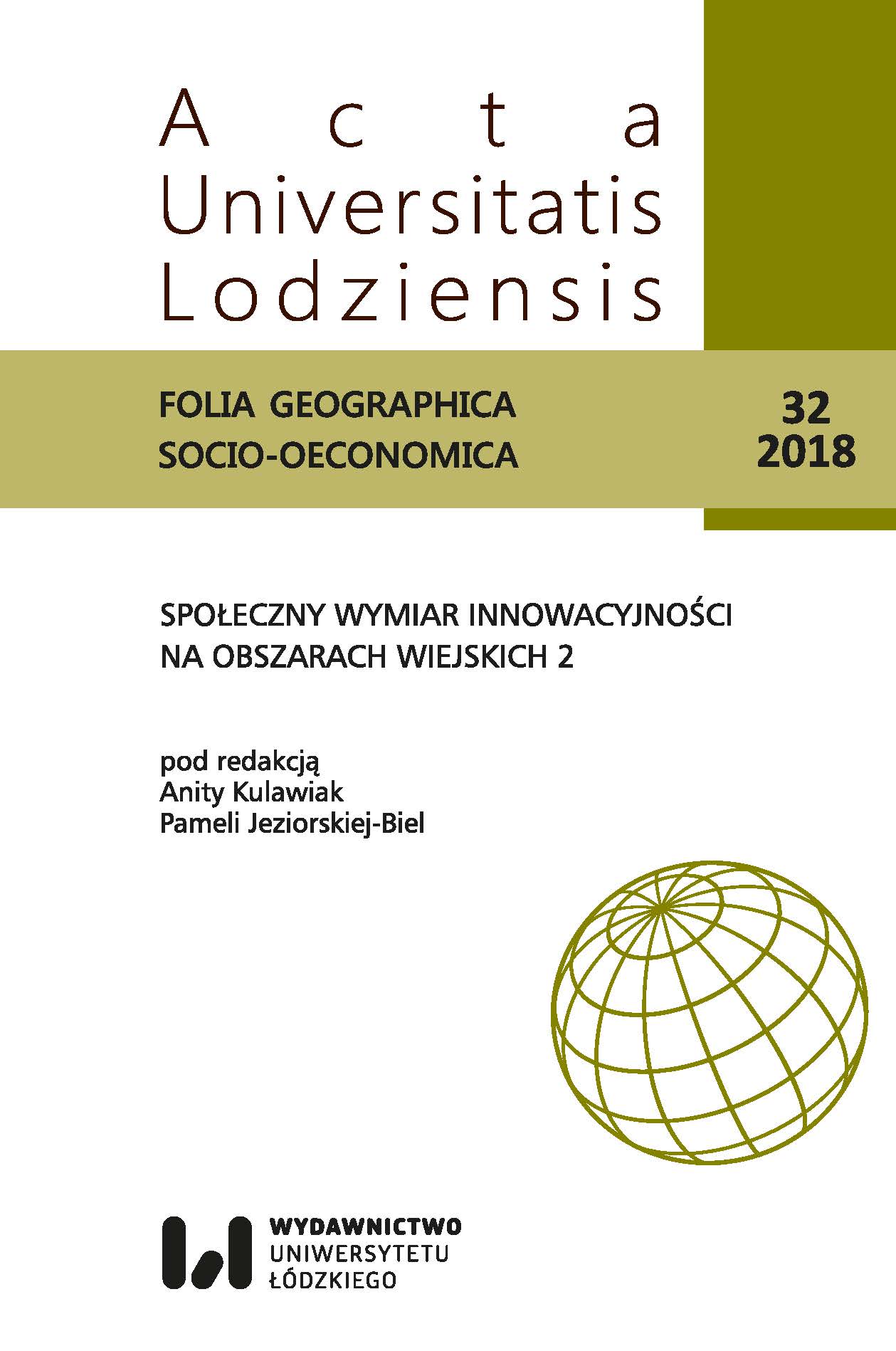Programowanie sanacji przestrzeni wiejskiej. Autorskie mechanizmy planistyczne na rzecz zrównoważonego kształtowania obszarów wiejskich
DOI:
https://doi.org/10.18778/1508-1117.32.02Słowa kluczowe:
planowanie przestrzenne, obszary wiejskie, strategiczne rezerwy inwestycyjne, metoda FASTAbstrakt
W pierwszej części artykułu autorzy diagnozują problemy procesu planowania przestrzennego w Polsce wynikające z obowiązującego systemu prawnego oraz identyfikują ich efekty w przestrzeni wiejskiej. W drugiej części skupiają się na prezentacji trzech wątków badawczych, stanowiących propozycję aplikacyjnych metod wdrażanych eksperymentalnie do procesu planistycznego, bazując na doświadczeniach praktycznych. W podsumowaniu konstruują listę rekomendacji dotyczących programowania sanacji zagospodarowania obszarów wiejskich.
Bibliografia
Agencja Bezpieczeństwa Wewnętrznego (ABW), 2005, Korupcja w Polsce – próba analizy zjawiska, Raport Agencji Bezpieczeństwa Wewnętrznego, Warszawa.
Google Scholar
Barełkowski R., 2005, Web-based social participation in the process of town planning, [w:] Duarte J.P., Ducla-Soares G., Zita Sampaio A. (red.), Digital Design: The Questfor New Paradigms, Technical University of Lisbon, Lisbon: 557–564.
Google Scholar
Barełkowski R., 2008, Web-based support for social participation and education in planning procedures, [w:] Muylle M. (red.), Architecture in „Computro”, University College of Antwerpen, College of Design Sciences, The Higher Institute of Architectural Sciences, Antwerp: 823–828.
Google Scholar
Barełkowski R., 2009, Prawo – czynnik instrumentalizacji przestrzeni, Międzynarodowa Konferencja Naukowa, Międzyuczelniana: „Krajobrazy Europy. Gospodarka planowa czy generowanie chaosu?”, Panel 1, „Krajobraz jako celowy czy ‚uboczny produkt’ działalności architekta i planisty”: III konferencja z cyklu „Oblicza równowagi”, Politechnika Wrocławska, Wrocław.
Google Scholar
Barełkowski R., 2012, The Edge of the [dis]Order, [w:] Pacetti M., Passerini G., Brebbia C.A., Latini G. (red.), The Sustainable City VII. Urban Regeneration and Sustainability, „WIT Transactions on Ecology and the Environment”, 155, Wessex Institute of Technology, WIT Press, Southampton & Boston: 759–770.
Google Scholar
Barełkowski R., 2014, Strategies for identity of sustainable suburbs, [w:] Marchettini N., Brebbia C.A., Pulselli R., Bastianoni S. (red.), The Sustainable City IX. Urban Regeneration and Sustainability, „WIT Transactions on Ecology and the Environment”, 191, Wessex Institute of Technology, WIT Press, Southampton & Boston: 667–679.
Google Scholar
Barełkowski R., 2015, FAST Matrix – depicting the time-related aspect of urban development, [w:] Brebbia C.A., Flores-Escobar W.F. (red.), The Sustainable City X. Urban Regeneration and Sustainability, „WIT Transactions on Ecology and the Environment”, 194, Wessex Institute of Technology, WIT Press, Southampton & Boston: 3–10.
Google Scholar
Barełkowski R., Barełkowska K., 2003, Struktura metody planowania przestrzennego P.R.S. – podstawy teoretyczne, [w:] Barełkowski R. (red.), Przestrzeń architektury a przestrzeń kulturowa, Ośrodek Wydawnictw Naukowych, Poznań: 7–22.
Google Scholar
Barełkowski R., Barełkowska K., Chlasta L., Wardęski Ł., 2013, Plany ochronne – narzędzie zachowania walorów krajobrazowych, [w:] Barełkowski R. (red.), Harmonizowanie przestrzeni. Perspektywy, studia, interwencje, Wydawnictwo Exemplum, Poznań: 137–147.
Google Scholar
Barełkowski R., Wardęski Ł., Wojtyra B., 2016a, Metodologiczne i praktyczne aspekty oceny aktualności studium i planów miejscowych na rzecz kreacji polityki przestrzennej = Methodological and Practical Aspects of the Assessment of Validity of Development Study for Creation of Spatial Policy, „Przestrzeń i Forma”, 28, Szczecin: 143–164.
Google Scholar
Barełkowski R., Barełkowska K., Chlasta L., Janusz J., Wardęski Ł., 2016b, Czasoprzestrzeń miasta. FAST: rozpoznanie i planowanie dla zrównoważonego rozwoju, „Przestrzeń i Forma”, 25, Szczecin: 151–186.
Google Scholar
Borkowski Z.H., 2011, Metoda badania marginalności obszarów wiejskich, „Barometr Regionalny”, 3 (25): 7–12.
Google Scholar
Brzeziński C., 2013, Wybrane problemy planowania przestrzennego w Polsce, „Acta Universitatis Lodziensis. Folia Oeconomica”, 289: 105–114.
Google Scholar
Czarnik Z., 2010, Istota i zakres władztwa planistycznego gminy, „Administracja: Teoria, Dydaktyka, Praktyka”, 3 (20): 5–30.
Google Scholar
Górecki J., 2015, Wybrane problemy rozwoju i transformacji rolnictwa, „Problemy Rolnictwa Światowego. Zeszyty Naukowe Szkoły Głównej Gospodarstwa Wiejskiego w Warszawie”, 15 (XXX), 1/2015: 33–38.
Google Scholar
Hajduk S., Baran A., 2013, Planowanie przestrzenne gmin a proces inwestycyjny – zagadnienia problematyczne, „Optimum. Studia Ekonomiczne”, 2/62: 117–129.
Google Scholar
Izdebski H., Nielicki A., Zachariasz I., 2007, Zagospodarowanie przestrzenne. Polskie prawo na tle standardów demokratycznego państwa prawego, Raport Sprawne Państwo, Program Ernst & Young, Warszawa.
Google Scholar
Kolipiński B., 2014, Planowanie przestrzenne w Polsce w minionym 25-leciu, „Mazowsze. Studia Regionalne”, 15: 109–118.
Google Scholar
Kowalik T., 2000, Współczesne systemy ekonomiczne. Powstanie, ewolucja, kryzysy, Wydawnictwo Wyższej Szkoły Przedsiębiorczości i Zarządzania im. L. Koźmińskiego, Warszawa.
Google Scholar
Kowalik T., 2001, Społeczne aspekty transformacji a rola państwa, „Gospodarka Narodowa”, 9: 28–47.
Google Scholar
Kowalik T., 2007, Polska transformacja a nurty liberalne, „Ekonomista”, 6: 781–797.
Google Scholar
Ministerstwo Infrastruktury i Budownictwa (MIiB), 2016, Problemy w dziedzinie planowania przestrzennego, Materiał informacyjny na posiedzenie Komisji Samorządu Terytorialnego i Polityki Regionalnej w dniu 11 maja 2016 roku, Warszawa.
Google Scholar
Najwyższa Izba Kontroli (NIK), 2011, Informacja o wynikach kontroli realizacji zadań w zakresie planowania i zagospodarowania przestrzennego przez organy administracji rządowej i jednostki samorządu terytorialnego, Departament Środowiska, Rolnictwa i Zagospodarowania Przestrzennego, Najwyższa Izba Kontroli, Warszawa.
Google Scholar
Najwyższa Izba Kontroli (NIK), 2016, Informacja o wynikach kontroli. System gospodarowania przestrzenią gminy jako dobrem publicznym, Departament Infrastruktury, Najwyższa Izba Kontroli, Warszawa.
Google Scholar
Raport o ekonomicznych stratach i społecznych kosztach niekontrolowanej urbanizacji w Polsce, 2013, Instytut Geografii i Przestrzennego Zagospodarowania PAN, Warszawa. Schoemaker P.J.H., 1995, Scenario planning: a tool for strategic thinking, „Sloan Management Review”, 36 (2), Massachussetts Institute of Technology, Cambridge, Mass: 25–40.
Google Scholar
Szwajdler W. (red.), 2013, Aspekty prawne planowania i zagospodarowania przestrzennego, LEX Wolters Kluwer Polska SA, Warszawa.
Google Scholar
Śleszyński P., Komornicki T., Solon J., Więckowski M., 2012, Planowanie przestrzenne w gminach, Instytut Geografii i Przestrzennego Zagospodarowania PAN, Wydawnictwo Akademickie Sedno, Warszawa.
Google Scholar
Wojtyra B., 2017, Zasoby lokalne w planowaniu przestrzennym centrum wsi – studium przypadku Rokietnicy, „Studia Obszarów Wiejskich”, 45: 125–140.
Google Scholar
Woźniak M., 2015, Ład przestrzenny jako paradygmat zrównoważonego gospodarowania przestrzenią, „Białostockie Studia Prawnicze”, 18: 167–182.
Google Scholar
Zagóra-Jonszta U., 2017, Polscy ekonomiści o przebiegu i skutkach transformacji, „Studia Ekonomiczne. Zeszyty Naukowe Uniwersytetu Ekonomicznego w Katowicach”, 316: 208–219.
Google Scholar
Ustawa z dnia 27 marca 2003 roku o planowaniu i zagospodarowaniu przestrzennym (Dz.U., 2017, poz. 1073, z późn. zm.).
Google Scholar
Ustawa z dnia 9 października 2015 roku o rewitalizacji (Dz.U., 2017, poz. 1023, z późn. zm.).
Google Scholar








